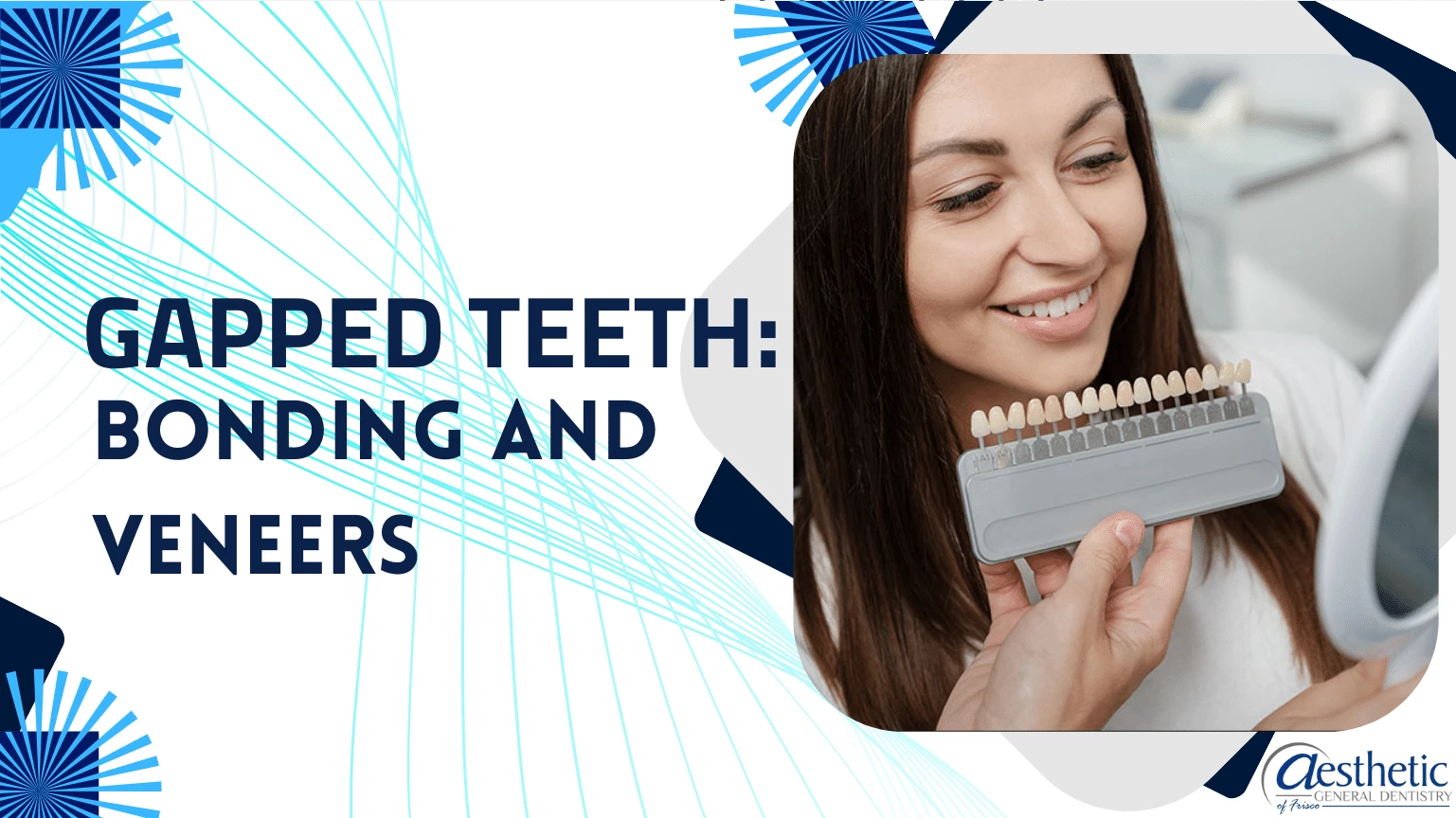Diastema, or gaps between teeth, can be fixed with dental bonding, which is a cheap and minimally invasive method. This means putting resin that looks like teeth on the teeth and shaping and polishing it so that it fits well with the other teeth. This makes the spaces look a lot smaller. People who want a quick fix should think about bonding because the whole thing can usually be done in one trip to the dentist.
Dental veneers, on the other hand, are a more complete and long-lasting way to fix gaps in teeth. Porcelain or composite make up thin veneers that cover the fronts of teeth to make them look even and natural.
Veneers can make a person’s smile look a lot better and last for years if they are taken care of properly. The process is more complicated than bonding and sometimes requires removing a small amount of enamel.
What Are The Main Differences Between Bonding And Veneers, And How Do They Help Fix Teeth That Are Too Far Apart?
Veneers and bonding are both cosmetic dental procedures that can fix teeth that have gaps, but they do so in different ways:
Dental bonding uses a tooth-colored composite resin to bond directly to the teeth to fill in gaps, chips, or discoloration. For teeth with gaps, the bonding material is put on the edges of the teeth to fill in the space and make them look even. Bonding is a quick and easy procedure that usually doesn’t need much work on the teeth and only requires one trip to the dentist.
Veneers are thin shells made of porcelain or composite resin that go over the front teeth to keep them safe. Veneers can fix cosmetic problems like gaps between teeth, stains, chips, and small misalignments. A small amount of enamel is taken off the front teeth to make room for the veneers and make sure they look natural.
Veneers are made by dental labs by taking impressions of the patient’s teeth. The veneers are glued to the teeth at a later dental appointment.
The main differences between veneers and bonding are:
- Material: Bonding uses a composite resin that is put directly on the teeth and shaped into the shape you want. Veneers, on the other hand, are usually made of porcelain or composite resin and are made in a dental lab before being attached to the teeth.
- Durability: Veneers are usually stronger and less likely to stain than bonding material, so they are a better long-term fix for cosmetic problems. But bonding can wear out and get dirty, so it may need to be fixed or replaced more often. Some enamel needs to be taken off the front of the teeth to make sure the veneers fit and look good. On the other hand, bonding doesn’t need much or any tooth preparation.
- Appearance: Both bonding and veneers can make your teeth look more natural, but veneers may look more real because they can look like the way natural tooth enamel reflects and refracts light.
In the end, the choice between bonding and veneers depends on the size of the gap between the teeth, the patient’s cosmetic goals, their budget, and the dentist’s advice based on the situation.
Is There A Reason Why Bonding Is Better Than Veneers For Closing Gaps Between Teeth, Or Vice Versa?
Patients usually have to choose between dental bonding and veneers to fill in gaps between their teeth based on a few things that are unique to them:
- Cost: Getting veneers is more expensive than bonding teeth. People often choose it because it’s cheap or because they want a quick fix that doesn’t cost too much.
- Time for treatment: You can bond in one visit, which is great for people who want results right away. For veneers, you need to go to the dentist at least twice: once to talk about them and make them, and once to put them on.
- Taking care of tooth enamel: Bonding doesn’t require much or any removal of the tooth’s enamel, which keeps more of the tooth’s natural structure. You can’t put on veneers without taking off some enamel.
- Durability: Veneers usually last longer than bonding does. Even though veneers are more expensive and take more work, patients may choose them as a long-term solution.
There are, however, some situations where someone might choose veneers over dental bonding:
- Aesthetics: Veneers give you a better look because they look more like real teeth and are more see-through. People who want to change their looks a lot often choose veneers.
- Stain Resistance: If you’re worried about your teeth changing color, veneers are a better choice than the resin used in bonding because they are less likely to stain.
- Longevity: Veneers usually last longer than bonding, so even though they cost more up front, they may be a more permanent solution that costs less in the long run.
- Size of the Gaps: If the gaps are big or there are a lot of teeth involved, veneers can make the teeth look more full and even. Dental bonding might work better if you only have one tooth or a small gap.
How Do You Usually Get Bonding Or Veneers To Fix Teeth That Are Too Far Apart, And How Long Does Each Procedure Take?
Usually, fixing gaps in your teeth with bonding or veneers takes a few steps:
- Talk to a dentist or cosmetic dentist first for a consultation and an exam. The dentist will check your teeth and talk to you about your worries at this appointment. They will also choose between bonding and veneers to fill in the space between your teeth.
- If you want veneers, the dentist will remove a small amount of enamel from the front of your teeth to prepare them. This step makes room for the veneer and makes sure it looks real. Most of the time, bonding doesn’t require any work on the teeth.
- The dentist will take impressions of your teeth after they have been cleaned, if that is needed. These imprints are used to make custom veneers or bonding materials that will fill in the gap.
- Skilled workers in a dental lab make the impressions of the veneers based on what the dentist wants. You can make the bonding material in the office and put it on your teeth at the same appointment.
- You will need to make an appointment to have the dental implant put in after the veneers or bonding material gets there. To attach veneers to teeth, the dentist will either use a delicate bonding agent or fill the gap with the bonding material and shape it to get the look they want.
- The dentist will make any changes needed after the placement to make sure everything fits, feels good, and looks good. This could mean trimming or polishing the veneers or the glue that holds them together.
The length of each step depends on how many teeth need to be treated, how difficult the case is, and whether the teeth need to be prepared first. Usually, a bonding appointment lasts 30 minutes to an hour for each tooth. Two treatments of one to two hours each are needed to get the teeth ready and make impressions for veneers. It could take weeks, from the first meeting to the placement.
Are There Any Risks Or Side Effects That People Should Be Aware Of When They Get Bonding Or Veneers For Their Gapped Teeth?
Bonding and veneers are usually safe and work well to fill in gaps in teeth, but there are some risks and side effects that people should be aware of:
- To prepare teeth for veneers, some enamel must be removed. This can make the tooth weaker and more likely to break or get damaged in the future. This risk is lower because bonding usually doesn’t require much or any preparation of the teeth.
- Very few people are allergic to the materials used in bonding or veneers, such as composite resin or dental cement. When you have an allergy, your gums may become inflamed, irritated, or show other allergic signs.
- The bonding material or the veneer materials may get stained or discolored over time, especially if they come into contact with certain foods, drinks (like coffee or red wine), or tobacco products. You can lower this risk by brushing your teeth and avoiding things that can stain them.
- Bonding material and veneers are tough, but they can still chip or break if you hit them too hard or hurt them. You can help protect your teeth by not biting down on hard things (like ice or pens) and wearing a mouthguard while playing sports.
- If bonding or veneers don’t fit right or are put in the wrong place, they can hurt the gums and make them swell or pull back. Putting things in the right place and going to the dentist on a regular basis can help you avoid this problem.
- Over time, both bonding and veneers may need to be replaced or fixed because they wear out, get damaged, or your oral health changes. People who want to fix their gapped teeth for good should think about this.
Before getting bonding or veneers, people should talk to their dentist about these possible risks and side effects. They should also know what to expect and how to take care of their teeth. You need to see the dentist often and take care of your teeth to keep bonding or veneers healthy and make them last a long time.
Let’s Help You Choose The Best Option For Your Teeth!
We promise to find a gap solution at Aesthetic General Dentistry of Frisco that works with your dental needs and way of life. Our knowledgeable staff is here to help you through the process, whether you choose dental bonding for its low cost and practical benefits or veneers for a more permanent and beautiful change.
Your comfort is our top priority, and we make sure that your treatment makes your smile and oral health better. We can help you make the best decision and come up with a care plan that works for you. Contact us for more information!

